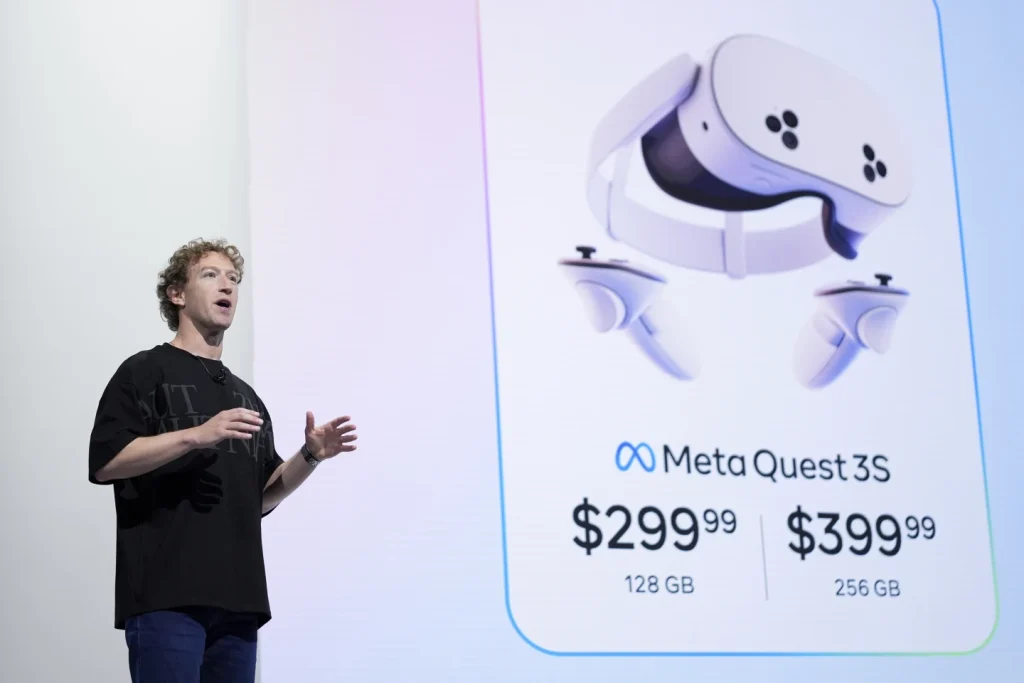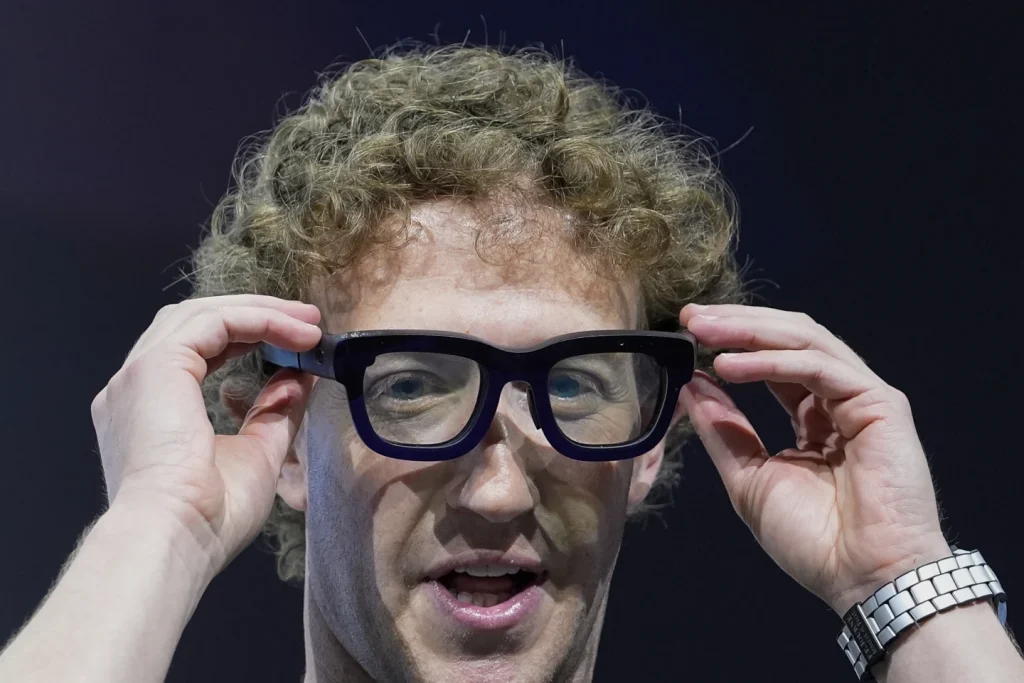In a transformative moment for the realm of technology, Meta has unveiled noteworthy upgrades to its virtual reality (VR) headset and Ray-Ban smart glasses.
This announcement, made by CEO Mark Zuckerberg at the company’s headquarters in Menlo Park, California, reflects Meta’s ambition to establish itself as a leader in artificial intelligence (AI) and next-generation computing platforms, thereby positioning itself beyond the conventional limitations of smartphones and computers.
The prototype glasses, named Orion, and the updates to Meta’s existing technologies serve not only as a testament to Meta’s innovative prowess but also embody the convergence of augmented reality (AR), artificial intelligence, and wearable technology.
The recent announcements suggest a significant leap towards practical applications of augmented reality and virtual reality technologies.
Zuckerberg’s introduction of Orion serves to underscore the technical challenges associated with developing such advanced devices. Orion has been described as “the most advanced glasses the world has ever seen,” embodying the company’s vision of seamlessly integrating technology into everyday life.
The design considerations for Orion are formidable; it must emulate the form factor of traditional glasses, remain lightweight—below 100 grams (approximately 3.5 ounces)—and avoid cumbersome wires, thus presenting numerous engineering challenges.
Beyond conventional interaction methods such as voice and hand gestures, Orion includes a groundbreaking “wrist-based neural interface.”
This innovative feature allows users to transmit signals from their brains to the device through a wristband that interprets nerve signals as digital commands, thus illustrating a paradigm shift in human-computer interaction.
While no release date has been specified, Zuckerberg has indicated that Orion provides merely “a glimpse of the future,” reflective of Meta’s forward-thinking ethos.
Meta’s latest developments extend beyond hardware updates; they signify a bold commitment to creating an AI-driven ecosystem that enhances user experience through more personal and interactive technologies.
In this endeavor, Meta has updated its Llama AI model, enabling users to interact with the AI through spoken communication while utilizing voices of renowned celebrities such as John Cena, Judi Dench, and Awkwafina.
This feature is indicative of a marketing strategy that aims to humanize and popularize AI interactions, thereby fostering a more natural and engaging user experience.
Zuckerberg articulated a vision “to build a future that is more open, more accessible, more natural, and more about human connection,” thereby establishing a direct link between Meta’s values and its technological advancements over the past two decades.
Among the most notable features showcased during the event was an AI function designed specifically for influencers, allowing content creators to generate AI counterparts capable of interacting with their fans.
This feature epitomizes a significant evolution in content creation and audience engagement, augmenting how fans connect with their favorite personalities.
The demonstration of an AI version of the creator, Don Allen Stevenson III, provided a tangible example of this capabilities, wherein these digital avatars could engage in real-world discussions, bridging the gap between creators and their audiences.
Furthermore, the live translation feature showcased on stage, which enabled real-time translations between Zuckerberg and Mexican mixed martial artist Brandon Moreno, highlights the potential for AR and AI technologies to transcend linguistic barriers and facilitate global communication.
Meta’s advancements in AI are noteworthy, as the company has reported significant user engagement, now boasting approximately 500 million users for its AI platforms.
As noted by industry analysts, this development marks a pivotal shift for Meta, illustrating its transformation from a traditional social media corporation into a formidable AI powerhouse.
This transition is underscored by the introduction of voice functionalities that challenge competitors like OpenAI, signaling Meta’s commitment to enhancing real-world utility within its technological offerings.
On the front of virtual reality, Meta’s introduction of the Quest 3S model represents a strategic move to capture a broader market segment by offering a more affordable VR solution priced at $299, in contrast to its standard Quest 3 model, which retails at $499.
This pricing strategy positions Meta competitively against Apple’s Vision Pro, priced significantly higher at $3,500, indicating Meta’s intention to dominate the mid-tier AR/VR market by making access to advanced technology more accessible to the general public.
In parallel, the augmented reality Ray-Ban smart glasses have emerged as an unexpectedly successful product for Meta.
Despite the company’s initial hesitance to disclose sales figures, Zuckerberg’s statement during Meta’s July earnings call indicates a fast-growing demand for these glasses, further boosted by the integration of AI features.
The glasses exemplify a “perfect form factor for AI,” enabling an AI assistant to perceive and interpret the user’s surroundings—thus enhancing the functionality of the device.
This innovation not only boosts the utility of wearable technology but encapsulates the essence of how augmented reality can enhance everyday human experiences.
Meta, the company formerly known as Facebook, which underwent a significant rebranding in 2021, continues to generate the vast majority of its revenue from advertising, with an astonishing 98% of its more than $39 billion in revenue during the most recent quarter derived from this stream.
This unwavering reliance on advertising underscores the centrality of this business model within Meta’s operational framework, even as the company boldly invests substantial resources into artificial intelligence and pioneering technologies that its CEO, Mark Zuckerberg, posits as the next evolution of computing platforms, including virtual reality (VR) headsets and augmented reality (AR) glasses.
While Zuckerberg’s vision for VR has garnered attention, industry experts like Forrester research director Mike Proulx express skepticism about the mainstream acceptance of VR headsets, citing their cumbersome nature and the discomfort users experience when subjected to prolonged usage, which seems to limit their appeal to short, intermittent sessions.
In contrast, Proulx advocates for the potential of AR glasses, asserting that they seamlessly integrate computing capabilities into a familiar and readily acceptable form factor, thereby enhancing everyday interactions between consumers and brands.
As he highlights the Orion prototype’s role in this narrative, Proulx envisions a transformative future in which a groundbreaking 3D computing platform becomes practically beneficial to the average consumer, fundamentally reshaping how individuals engage with digital content and, consequently, with the businesses that cater to them.

This duality of challenges and opportunities encapsulates Meta’s current trajectory, poised at the intersection of traditional advertising revenue and the advent of immersive, smart technologies that could redefine consumer-brand relationships in the digital age.
In summary, Meta’s recent unveiling of its software and hardware advancements signifies a pivotal moment in the intersection of artificial intelligence and augmented/virtual reality technologies.
The ambitious vision presented by Zuckerberg encapsulates not merely a shift in device capabilities but represents a broader narrative regarding the evolution of human interaction with technology.
As Meta endeavors to “bring the future to everyone” with its cutting-edge products, we stand at the precipice of a new era in which augmented reality, virtual reality, and artificial intelligence coalesce to create immersive, interconnected experiences.
These developments not only redefine the possibilities of technology but also foster a deeper connection between humans and the digital universes they inhabit. As Meta strides forward, the world watches, intrigued by the potential that lies ahead in this rapidly evolving landscape.
